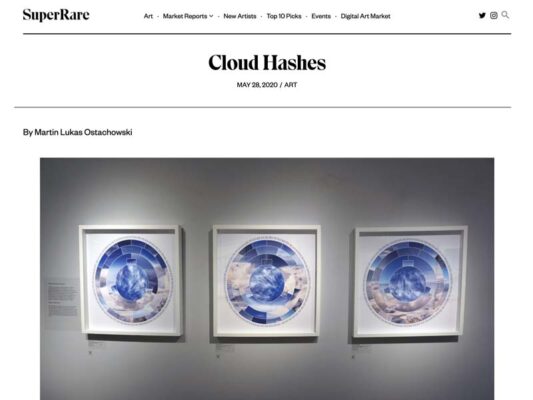
Artwork Description
Cloud Hashes is a visualization of the SHA-256 hash algorithm used in blockchain technology. This digital animation is one of the three artworks of this visualization and serves as the augmented reality layer for a limited edition print of five.
SHA-256 Background
Since Bitcoin uses the SHA-256 algorithm, my artwork visualizes and references many elements of this hash function. SHA stands for Secure Hash Algorithm and 256 for the number of bits. Designed by the NSA, this SHA-256 algorithm creates a unique fingerprint of any text or file mathematically. This unique fingerprint is called the hash. What makes it secure and desirable is that with the slightest modification of the original text, the output hash is entirely different.
Example 1: “crypto art” results in the following hash:
67DAC4E220E4D161A36FD3E7312B2F7AC3333498CF946CEBE5D48EB6F222AA37
Example 2: “Crypto art” with a capital C leads to the following hash:
69AAE4DC4E666E0EA56EF15AAA6EEC30DF2F6015DF6CB964FCB5E80DB41CA17A
It is just as easy to verify the integrity of vast amounts of data, i.e. the contents of all books ever written, as they can be hashed to the exact same-length output hashes. In the following, I will deconstruct some of my SHA-256 algorithm references.
Cloud Hashes – Deconstructed
In a nutshell, the center photo represents the input, which leads to the creation of a SHA-256 hash in the outer ring. The rings in between represent the several stages the algorithm works through to convert this input to an output hash. In the first step, the hashing algorithm splits the input image into its fundamental parts. The algorithm converts the input to binary code and pads it with additional bits to comply with its specified length to operate further. The compression algorithm then mathematically slices, stretches, shuffles and scatters the data iteratively. Even the slightest change to the initial input image drastically changes the result of each iteration. This desirable effect is called the avalanche effect. In the last step, the algorithm converts the binary code to base-16, a hexadecimal numeral system. The 16 segments in this ring represent the possible values 0-9 and A to F. The hexadecimal format is the format we humans interact with hashes since it is substantially shorter.
The outer ring shows the real SHA-256 hash. Sixty-four blocks build the 64 alphanumerical characters of the output hash. Each block consists of 4 binary bits, which allow precisely 16 possible values. To better visualize the hexadecimal value, I created a readable small-caps font based on this grid of 16.
Digital Artwork Information
Physical Artwork Information
Related Exhibitions & Events

Bitcoin Art Gallery
Bitcoin Art Gallery was an international showcase of Bitcoin artists during the Bitcoin 2021 conference.
Related Press & Mentions

SuperRare Editorial: Cloud Hashes Series
SuperRare Editorial featured my new visualization series of the SHA-256 hashing algorithm.
Related Blog Posts

Cloud Hashes Visualization
I released a new series which visualizes the SHA-256 hashing algorithm.
